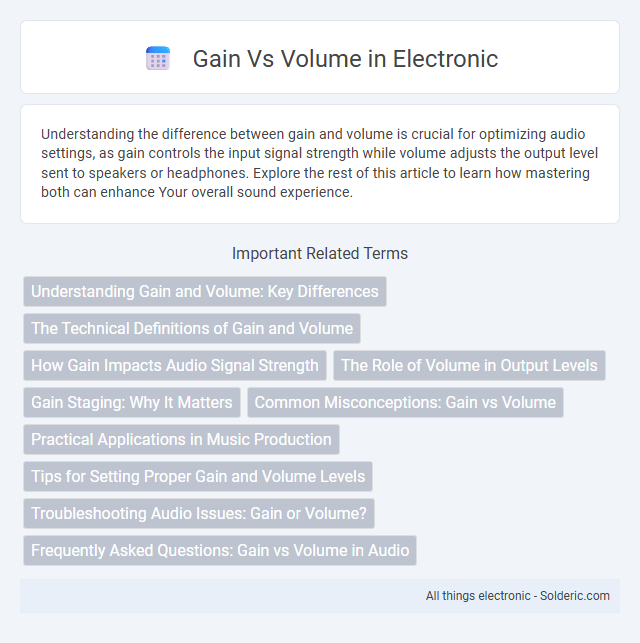Understanding the difference between gain and volume is crucial for optimizing audio settings, as gain controls the input signal strength while volume adjusts the output level sent to speakers or headphones. Explore the rest of this article to learn how mastering both can enhance Your overall sound experience.
Comparison Table
| Feature | Gain | Volume |
|---|---|---|
| Definition | Adjusts the input signal strength before processing. | Controls the output level sent to speakers or headphones. |
| Function | Amplifies and shapes the audio signal to optimize sound quality. | Regulates the final loudness of the audio output. |
| Impact on Sound | Affects signal-to-noise ratio and potential distortion. | Changes audio loudness without altering tone. |
| Adjusts | Preamp or input stage levels. | Output audio level. |
| Common Use | Setting proper input sensitivity on mixing consoles, amplifiers. | Controlling playback loudness on audio devices. |
| Typical Controls | Knob labeled "Gain" or "Trim". | Knob labeled "Volume" or "Level". |
Understanding Gain and Volume: Key Differences
Gain controls the intensity of the input signal before it reaches the amplifier, affecting the level of distortion and saturation, while volume adjusts the output loudness without altering the signal's character. Understanding the distinction between gain and volume is essential for achieving the desired tonal quality in your audio setup. Proper management of gain ensures clarity and dynamic range, whereas volume controls the overall sound level perceived by your audience.
The Technical Definitions of Gain and Volume
Gain refers to the amplification level of an audio signal before it passes through other processing stages, controlling the strength of the input signal entering a device or effect. Volume, on the other hand, determines the loudness or output level of the audio after amplification, directly affecting what you hear from speakers or headphones. Understanding the technical difference between gain and volume is crucial for optimizing sound clarity and preventing distortion in audio equipment.
How Gain Impacts Audio Signal Strength
Gain directly controls the amplitude of the input audio signal, increasing its strength before any processing or amplification occurs. Adjusting gain affects the signal-to-noise ratio, where excessive gain can introduce distortion and clipping, compromising audio clarity. Proper gain staging ensures an optimal balance, maximizing signal strength while maintaining sound fidelity throughout the audio chain.
The Role of Volume in Output Levels
Volume controls the strength of the audio signal sent to the output, directly affecting the loudness perceived by the listener. Unlike gain, which adjusts the input signal strength and can introduce distortion or noise, volume operates on the already processed signal to manage output levels cleanly. Proper volume adjustment ensures optimal sound levels without compromising audio quality or causing damage to speakers.
Gain Staging: Why It Matters
Proper gain staging ensures your audio signal maintains optimal clarity and avoids distortion throughout the recording and mixing process. Managing gain levels at each stage preserves dynamic range and prevents unwanted noise, resulting in a cleaner, more professional sound. Understanding the difference between gain and volume helps you control input sensitivity (gain) without affecting the output loudness (volume).
Common Misconceptions: Gain vs Volume
Many users mistakenly believe gain and volume control the same aspect of sound, but gain adjusts the input signal strength affecting distortion and tone, while volume controls the output level to speakers or headphones. Increasing gain amplifies the signal before distortion circuits, altering the sound character, whereas volume only boosts the final sound output without affecting tone. Understanding this distinction is crucial for achieving desired audio effects and preventing unwanted noise or clipping.
Practical Applications in Music Production
Gain controls the initial signal strength entering your audio interface or mixer, crucial for maintaining clarity and preventing distortion in recordings. Volume adjusts the final output level heard through monitors or headphones, helping balance individual tracks in a mix without altering the raw audio quality. Understanding the distinction between gain and volume ensures precise control over dynamics and tonal balance during music production.
Tips for Setting Proper Gain and Volume Levels
Setting proper gain and volume levels is essential for clean audio production and avoiding distortion or noise. Adjust gain first by increasing it until the input signal peaks around -12 dB to -6 dB on the meter, ensuring optimal headroom and minimal clipping. Then, set the volume to a comfortable listening or mixing level without boosting it excessively, preserving sound clarity and dynamic range.
Troubleshooting Audio Issues: Gain or Volume?
Distinguishing between gain and volume is critical when troubleshooting audio issues because gain controls the input signal strength while volume adjusts the output loudness. Excessive gain can cause distortion and clipping, whereas improper volume settings may result in unbalanced sound or unwanted noise in the audio output. Diagnosing problems by checking both gain staging and volume levels ensures clarity and optimal sound quality in recording and playback environments.
Frequently Asked Questions: Gain vs Volume in Audio
Gain controls the strength of the input signal before processing, directly affecting audio clarity, while volume adjusts the output level to speakers or headphones. Excessive gain can cause distortion and noise, making it crucial to find the right balance with your volume settings for optimal sound quality. If your audio sounds muffled or distorted, check your gain levels first before adjusting the volume.
Gain vs Volume Infographic

 solderic.com
solderic.com